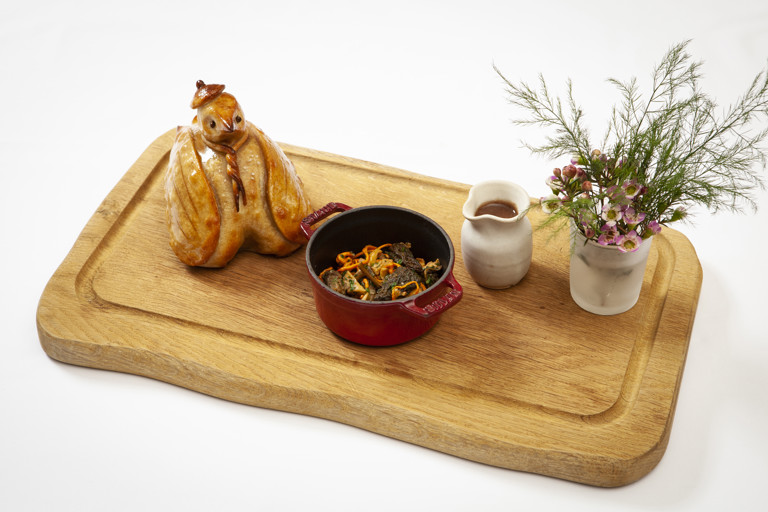Pigeon de Bresse baked in a salt pastry crust
- medium
- 2
- 1 hour 30 minutes
Impressive, playful and delicious all at the same time, this jovial little pigeon is baked in a salt crust, to be carved at the table. Served with a rich sauce and simple wild mushroom fricassée, this dish is for when you want to impress (and give your pastry shaping techniques a workout!). In season from late summer to the end of autumn.
'This dish is a thirty-year-old classic at Le Manoir; it is still a great favourite today. It has technique, beauty, deliciousness and the old lost skills of the dining room. It took me months to perfect the recipe, and for a few seconds I felt truly proud. Let me explain why.
First, the dish is hugely dramatic; it is a sculpture of a squab wrapped in its salt crust. But do not be mistaken, the aim was certainly not merely to create something beautiful. The salt crust has a very specific role to play. First, it seasons the squab while cooking. Then, it wraps it completely to seal in all its flavours. Even more importantly, it is not an aggressive heat as it would be if it were roasted directly in the oven. Because it is completely sealed, the heat takes time to build up inside and slowly permeates the squab, creating a melting tenderness and also a richer, deeper flavour. I would never place taste after aesthetics; my cuisine has always been inspired by taste and flavours, yet I try also to make my dishes visually exciting and appetising.'
Follow Raymond on Instagram, Twitter and Facebook. Recipe © Raymond Blanc.
Ingredients
Metric
Imperial
Pigeons
- 2 squab pigeons, , cleaned and oven-ready, with the wings, neck, heart and liver removed and reserved (ask your butcher)
- 1 tbsp of grapeseed oil
Salt crust
- 600g of strong white flour
- 350g of fine sea salt
- 6 egg whites
- 175ml of warm water
Sauce
- 2 tbsp of duck fat
- 4 shallots, finely chopped
- 100g of flat mushrooms, finely sliced
- 4 tbsp of Madeira, dry
- 4 tbsp of ruby port
- 200ml of brown chicken stock
- 1 tbsp of whipping cream
- 1 pinch of salt
- 1 pinch of freshly ground white pepper
Wild mushroom fricassée
- 120g of wild mushrooms, mixed
- 15g of unsalted butter
- 2 tbsp of flat-leaf parsley, chopped
- 1 sprig of tarragon, chopped
- 1 tsp chervil, chopped
- 1/2 garlic clove, minced
- 1 tsp shallots, finely chopped
- 2 pinches of sea salt
- 1 pinch of freshly ground black pepper
- 1 dash of lemon juice, to taste
Equipment
- Stand mixer
Method
- 2 squab pigeons, , cleaned and oven-ready, with the wings, neck, heart and liver removed and reserved (ask your butcher)
- 1 tbsp of grapeseed oil
- 600g of strong white flour
- 350g of fine sea salt
- 6 egg whites
- 175ml of warm water
- 2 tbsp of duck fat
- 4 shallots, finely chopped
- 100g of flat mushrooms, finely sliced
- 4 tbsp of Madeira, dry
- 4 tbsp of ruby port
- 200ml of brown chicken stock
- 1 tbsp of whipping cream
- 1 pinch of salt
- 1 pinch of freshly ground white pepper
- 2 egg yolks, beaten with 1 tbsp of water
- 120g of wild mushrooms, mixed
- 2 tbsp of flat-leaf parsley, chopped
- 1 sprig of tarragon, chopped
- 1 tsp chervil, chopped
- 1/2 garlic clove, minced
- 1 tsp shallots, finely chopped
- 2 pinches of sea salt
- 1 pinch of freshly ground black pepper
- 1 dash of lemon juice, to taste
- 15g of unsalted butter
Get in touch
Please sign in or register to send a comment to Great British Chefs.



